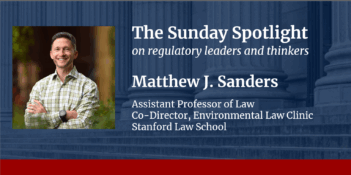
The rulemaking process in the United States is slow and biased toward business.
Many proponents of effective government regulation have lavished praise on the judicially enforced notice-and-comment rulemaking process that is required by section 553 of the Administrative Procedure Act and that dominates regulatory decision making by federal agencies. In theory, the notice-and-comment process provides a judicially enforced means through which all individuals and groups that have an interest in the outcome of a major regulatory decision making process, including beneficiaries, have an effective means of influencing its outcome. Recent empirical research exposes this widespread belief as completely fictional.
The notice-and-comment process invariably produces significant delay and systematic pro-regulatee bias in regulatory decision making. The delay effect has been the subject of numerous studies that describe and document the “ossification” of agency rulemaking. A few scholars have questioned the ossification hypothesis in recent years, including Anne Joseph O’Connell and Jason and Susan Webb Yackee, but my forthcoming article in the George Washington University Law Review should end that debate. I explain why and how using the judicially enforced notice-and-comment process routinely adds many years to an agency’s decision making process in high-stakes regulatory controversies.
The extreme torpor of the notice-and-comment process contrasts sharply with the speed and efficacy of the process of making major controversial regulatory decisions in a legal environment in which agencies are not required to use the notice-and-comment process and their decisions are not subject to judicial review. Jerry Mashaw has documented one example of this phenomenon. In less than three years – between 1852 and 1855 – the Steamboat Safety Commission issued a series of rules that reduced the incidence of steamboat explosions by over 80%. Steven Davidoff and David Zaring have documented a more recent example: in a period of months in 2008, the Federal Reserve and the Treasury Department took the many actions that were essential to keep the U.S. from experiencing a new great depression. In both cases, the key to the government’s ability to act effectively and expeditiously was the absence of mandatory decision making procedures and the unavailability of judicial review.
Two recent empirical studies document the powerful systemic bias in favor of regulated firms that is inherent in the judicially enforced notice-and-comment process. Wendy Wagner, Katherine Barnes, and Lisa Peters studied ninety notice-and-comment proceedings in which the Environmental Protection Agency (EPA) issued rules governing toxic substances. They found massive systemic bias in favor of regulated firms. Regulated firms submitted the vast majority of the detailed comments that had the potential to influence agency decision makers and to which agencies had to respond in order to satisfy reviewing courts. Regulated firms also dominated the informal meetings with agency decision makers that invariably took place during the lengthy rulemaking process. Beneficiaries and organizations that represented beneficiaries filed only a few generalized comments and engaged in only a few of the hundreds of informal meetings that took place with agency decision makers. Not surprisingly, the vast majority of changes in the rules under consideration favored the regulated firms.
Kimberly Krawiec’s forthcoming empirical study of rulemaking to implement the Dodd-Frank Act provides powerful evidence that the systemic bias in favor of regulated firms applies beyond the EPA context that Wagner et al. studied. Krawiec found that banks and associations representing banks filed numerous “meticulously drafted, argued and researched” comments and accounted for 93% of the meetings with agency decision makers. By contrast, the comments filed by beneficiaries and organizations representing beneficiaries were short and general. They consisted primarily of vituperative name calling directed at banks.
It is time for proponents of effective regulation to reconsider their support for judicially enforced notice-and-comment rulemaking in light of the growing body of evidence that it produces lengthy delays and rules that are systematically biased in favor of regulated firms.




